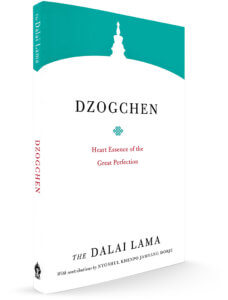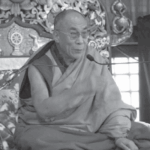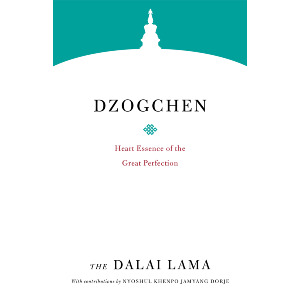
In these teachings, we find a number of themes recur. His Holiness explains why it is that Dzogchen is called “the pinnacle of all vehicles,” while at the same time the final teachings in all the Buddhist traditions of Tibet lead to the same ultimate point: the clear light. This is a subject, His Holiness admits, which fires his interest like few others, and a theme throughout these teachings, as he reveals the subtle affinities and differences between Dzogchen and the teachings and practices of the other schools of Tibetan Buddhism.
His Holiness seems moved by a concern to dispel the kind of misunderstandings that could come from a facile comparison of one tradition with another. During his teachings in London in 1984, he quoted a remarkable statement by Jamyang Khyentse Chökyi Lodrö (1893-1959), which throws light on the particular character of the teachings of the different schools:
As is said in an oral transmission by the great lama Jamyang Khyentse Chökyi Lodrö, when the great
Nyingmapa adept Longchen Rabjam gives a presentation of the ground, path and fruit, he does so
mainly from the perspective of the enlightened state of a Buddha, whereas the Sakyapa presentation is
mainly from the perspective of the spiritual experience of a yogi on the path, and the Gelukpa presentation
is mainly from the perspective of how phenomena appear to ordinary sentient beings. His statement
appears to be worthy of considerable reflection; through it many misunderstandings can be removed.
Naturally, in many places in these teachings, His Holiness speaks about the pure, pristine awareness of rigpa. As Dodrupchen Jikmé Tenpé Nyima explains: “Generally speaking, in the instructions on Dzogchen, profound and special aspects are endless. The key point, however, is the differentiation between the ordinary mind and
rigpa. As Jikmé Lingpa puts it in his Treasury of Enlightened Attributes:
Rigpa, which transcends the ordinary mind,
Is the special feature of the natural Dzogpachenpo.”
One factor to which His Holiness returns again and again here is the importance, for a practitioner, of a wider knowledge of the whole structure of the Buddhist teaching. Hand in hand with this, he underlines the need to learn how to interpret the specific terminology used in the different schools and strata of Buddhism. And at the same time as he insists on a more rigorous approach to studying the sources of Buddhism, His Holiness loses no opportunity to provide clues and instructions on how to apply specific points to the everyday business of living. In giving teachings such as these, it becomes clear that His Holiness’s aim is to strengthen the bases of Buddhadharma among practitioners in the west, by clarifying and deepening their understanding, and with an eye to the future stability and authenticity of the Dharma here.
In this book, His Holiness’s teachings appear in chronological order. Each one is prefaced by a brief sketch of the background to the teachings, allowing the reader to locate them in time and place, and also opening a window onto His Holiness’s interests and life. For these teachings and the events that took place around them are, in a very real sense, part of the Dalai Lama’s biography. Some of the important sources or masters to whom His Holiness refers are noted, although there is no need to dwell on the lives of the masters of the Dzogchen lineage mentioned here—Garab Dorje, Guru Padmasambhava, Longchen Rabjam, Jikmé Lingpa, Jikmé Gyalwé Nyugu, Patrul Rinpoche, Dodrupchen Jikmé Tenpé Nyima, Jamyang Khyentse Chökyi Lodrö and Dilgo Khyentse Rinpoche—when they have been recounted so authentically and with such beauty by Tulku Thondup Rinpoche in his Masters of Meditation and Miracles.
From “Preface” by Sogyal Rinpoche in Dzogchen: The Heart Essence of the Great Perfection by H.H. the Dalai Lama.


